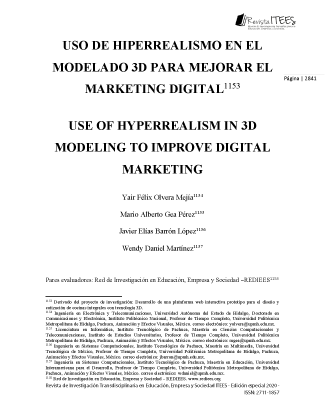CXLVIII. USE OF HYPERREALISM IN 3D MODELING TO IMPROVE DIGITAL MARKETING
##plugins.themes.bootstrap3.article.main##
Abstract
In this text, a website with hyper-realistic 3D models is designed, developed, and put into
operation as the main attraction, with the purpose of innovating the digital marketing of a
company dedicated to the sale of kitchens. Hyperrealism allows you to create a reality that is
simply virtual but that can be shown as something totally real, where colors, textures, light,
and dimensions of everything shown in the three-dimensional image are detailed. All the
stages for the creation of the hyper-realistic 3D models are described, such as: modeling, uv
mapping, texturing, and rendering. As well as for the development of the website, where the
user can interact with the virtual elements, while he/she can assemble his own kitchen by
changing designs, colors and measurements. Consequently, there is a considerable increase
in the number of visitors to the website and followers on social networks, as well as an
increase in requests for budgets and sales. This leads to the application of new marketing
strategies carried out only in digital media. There are also paradigm shifts, since if before the
distributors, the media and the producers were the ones who had the power of opinion, now
the center of attention shifts to the user.
Download Statistics
##plugins.themes.bootstrap3.article.details##
hyperrealism, digital marketing, 3d models, web pages, simulation
tool. Global business and management research: An international journal, 2(2), 237-
252.
Corrales, A. M., Coque, L. M., & Brazales, Y. P. (2017). El marketing digital y su influencia
en la administración empresarial. Dominio de las Ciencias, 3(4), 1161-1171.
Gabriel, F. G. (2010). Realism and realistic representation in the digital age. Journal of Film
and Video, 62(3), 3-16. https://doi.org/10.5406/jfilmvideo.62.3.0003.
García, J. S. (2011). Marketing para ciudades: las ciudades también se venden, las ciudades
también son productos. Pensar la publicidad. Revista internacional de investigaciones
publicitarias, 4(1), 211-226.
Kotler P. (2007). Marketing. España: Editorial Pearson Prentice Hall.
Kullmann, K. (2014). Hyper-realism and loose-reality: The limitations of digital realism and
alternative principles in landscape design visualization. Journal of Landscape
Architecture, 9(3), 20-31. https://doi.org/10.1080/18626033.2014.968412.
Moschini, S. (2012). Claves del marketing digital. La nueva comunicación empresarial en el
mundo, 3, 13794-2012.
Patrutiu-Baltes, L. (2016). Inbound Marketing-the most important digital marketing
strategy. Bulletin of the Transilvania University of Brasov. Economic Sciences. Series
V, 9(2), 61.
Salgado, P. S., & Pérez, L. R. V. (2015). Realidad aumentada como herramienta de
innovación dentro del proceso de venta de las Pymes. Revista Raites, 1(1), 45-60.
Wang, N., & Doube, W. (2011, May). How real is really? a perceptually motivated system
for quantifying visual realism in digital images. In 2011 International Conference on
Multimedia and Signal Processing (Vol. 2, pp. 141-149). IEEE.
https://doi.org/10.1109/CMSP.2011.172.
Yejas, D. A. A. (2016). Estrategias de marketing digital en la promoción de Marca
Ciudad. Revista Escuela de Administración de Negocios, (80), 59-72.
https://doi.org/10.21158/01208160.n80.2016.1457.





